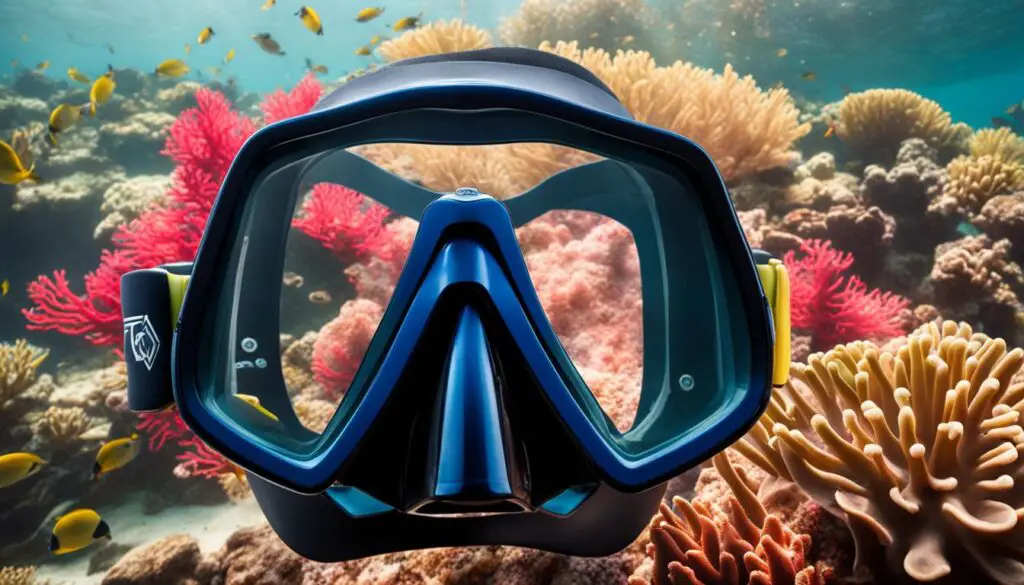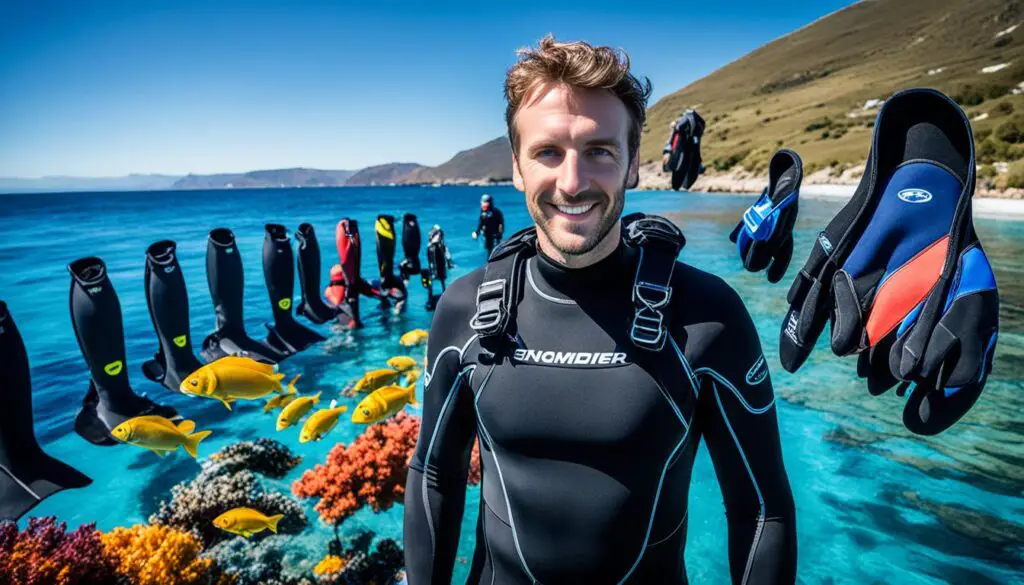Welcome to an exciting underwater adventure! If you’re ready to explore the mesmerizing depths of the ocean, it’s crucial to equip yourself with the essential scuba diving gear. Investing in top-quality gear ensures your safety and enhances your overall diving experience. Let’s dive into the details of what you need to gear up for your underwater expeditions.
Key Takeaways:
- Scuba diving requires specific gear for safety and an enhanced experience.
- The essential scuba diving gear includes a mask, snorkel, fins, wetsuit or drysuit, BCD, regulator, dive computer, and weight system.
- Opt for high-quality gear from reputable brands for durability and reliability.
Choosing the Right Mask, Snorkel, and Fins
When it comes to scuba diving, selecting the right gear is crucial for an enjoyable and safe experience. Among the essential items, a well-fitting scuba diving mask, snorkel, and fins play a vital role. Let’s dive into the key factors to consider when choosing these pieces of equipment.
The Perfect Fit: Scuba Diving Mask
A properly fitting scuba diving mask is essential for comfort and maintaining a watertight seal. Look for masks that come in different sizes to find the one that fits your face shape. A good quality mask should have a soft yet durable silicone skirt that adapts to the contours of your face. This ensures a snug fit, minimizing water leakage. Additionally, a mask with adjustable straps allows for a personalized fit.

Clear Vision: Key Features of Masks
When selecting a scuba diving mask, pay attention to its features. High-quality masks incorporate tempered glass lenses, which are more resistant to scratches and provide better clarity underwater. It’s also essential to choose a mask with a wide field of vision, allowing you to fully explore your surroundings.
Easy Breathing: Snorkels with Comfort and Functionality
A well-designed snorkel ensures effortless breathing while exploring underwater. Look for a snorkel with a comfortable mouthpiece that fits securely in your mouth without causing strain or discomfort. Additionally, a proper purge valve allows for easy clearing of water, ensuring uninterrupted breathing.
Propel with Style: Selecting Diving Fins
Choosing the right diving fins can greatly enhance your diving experience. Fins come in various designs and materials, such as open heel or full foot fins. When selecting fins, consider factors like style, fit, and propulsion efficiency. Some fins are designed for speed and power, while others prioritize comfort and ease of movement. Experiment with different fin types to find the ones that suit your diving style the best.
| Type | Advantages | Disadvantages |
|---|---|---|
| Open Heel | Provides adjustable fit with straps, ideal for cold water diving | Requires wearing booties for comfort |
| Full Foot | Easy to wear, suitable for warm water diving | Less adjustable, lack insulation in cold water |
Remember, finding the perfect scuba diving mask, snorkel, and fins is a personalized process. Take the time to try different options and consider your comfort, fit, and preferences. Investing in high-quality gear from reputable brands will ensure durability and reliability throughout your underwater adventures.
Selecting the Right Exposure Protection
Exposure protection is essential for scuba divers to regulate body temperature and ensure comfort during their underwater adventures. When it comes to exposure protection, two popular options are scuba diving wetsuits and drysuits. Let’s delve into the details of each and explore how they provide the necessary insulation and protection.
Scuba Diving Wetsuit
A scuba diving wetsuit is typically made of neoprene, a flexible and durable material that provides excellent insulation. Wetsuits work by trapping a thin layer of water between the suit and the diver’s skin. This water gets warmed by body heat, creating a protective barrier against the cooler water outside. The thickness of the wetsuit depends on the water temperature and personal preference.
Depending on the conditions you’ll be diving in, wetsuits come in different styles:
- Full wetsuits: Cover the entire body, including the arms and legs. These are suitable for colder water temperatures.
- Shorty wetsuits: Have shorter arms and legs, providing more freedom of movement. They are ideal for warm water diving.
- Farmer John/Jane wetsuits: Consist of a sleeveless or short-sleeved upper body and full-length pants. These offer versatility for different water temperatures.
Drysuit for Extreme Conditions
In colder and more extreme conditions, a drysuit may be the better choice for exposure protection. Unlike wetsuits, drysuits are designed to keep the diver completely dry by preventing water from entering. Drysuits have waterproof seals at the wrists, neck, and ankles, providing a watertight seal.
Drysuits allow divers to wear insulation layers underneath, making them ideal for prolonged exposures and frigid water. This additional insulation provides enhanced warmth during long dives or in icy waters.
When choosing exposure protection, consider the following factors:
- Water temperature: The colder the water, the thicker the exposure protection needed.
- Dive duration: Longer dives may require better insulation to maintain comfort throughout.
- Personal comfort: Some divers may prefer the flexibility and ease of movement provided by wetsuits, while others prioritize warmth and dryness with drysuits.
Ultimately, the choice between a scuba diving wetsuit and a drysuit depends on the diving conditions and personal preferences. It’s essential to select exposure protection that allows you to enjoy your dives comfortably, ensuring a memorable and safe underwater experience.

Ensuring Safety with BCD, Regulator, and Dive Computer
When it comes to scuba diving safety, the right equipment can make all the difference. Three crucial components for a safe and enjoyable dive are the buoyancy control device (BCD), regulator, and dive computer.
The BCD plays a vital role in maintaining buoyancy and stability underwater. It’s important to choose a BCD that fits properly and offers sufficient lift capacity. Look for models that also have integrated weight pockets, allowing for easy weight management during the dive.
The regulator is responsible for delivering a steady flow of air from the tank to the diver. A reliable regulator with proper breathing resistance and adjustable features is essential for a safe diving experience. Take the time to find a high-quality regulator that meets your specific needs and ensures smooth breathing throughout your dive.
Another essential piece of equipment is the dive computer. This tool provides crucial information about your dive, including depth, dive time, and decompression limits. Look for a dive computer with a user-friendly interface and advanced features to enhance safety and facilitate dive planning.
Investing in top-notch scuba diving gear, including a BCD, regulator, and dive computer, is crucial to ensure your safety and maximize your enjoyment underwater. Prioritize quality, functionality, and reliability when choosing these essential components, and always remember to properly maintain and service your gear for optimal performance.
FAQ
What gear is essential for scuba diving?
The essential scuba diving gear includes a mask, snorkel, fins, wetsuit or drysuit, buoyancy control device (BCD), regulator, dive computer, and weight system.
What should I consider when choosing a scuba diving mask?
When selecting a scuba diving mask, it’s important to find one that fits well and provides a comfortable seal. Look for a mask with tempered glass lenses and a wide field of vision.
What features should I look for in a snorkel?
Snorkels should have a comfortable mouthpiece and a proper purge valve.
What factors should I consider when choosing diving fins?
Consider factors like style, fit, and propulsion efficiency when choosing diving fins.
What should I consider when selecting exposure protection?
Consider factors like water temperature, dive duration, and personal comfort when selecting exposure protection. Wetsuits made of neoprene provide insulation and help retain body heat, while drysuits keep the diver completely dry and allow for insulation layers underneath.
What should I look for in a buoyancy control device (BCD)?
Look for a BCD that fits well, has sufficient lift capacity, and features integrated weight pockets for easy weight management.
What should I consider when choosing a regulator?
Choose a reliable regulator with proper breathing resistance and adjustable features.
Why is a dive computer important?
A dive computer is a vital tool for monitoring depth, dive time, decompression limits, and other important parameters. Opt for a dive computer with a user-friendly interface and advanced features to enhance dive safety and planning.
